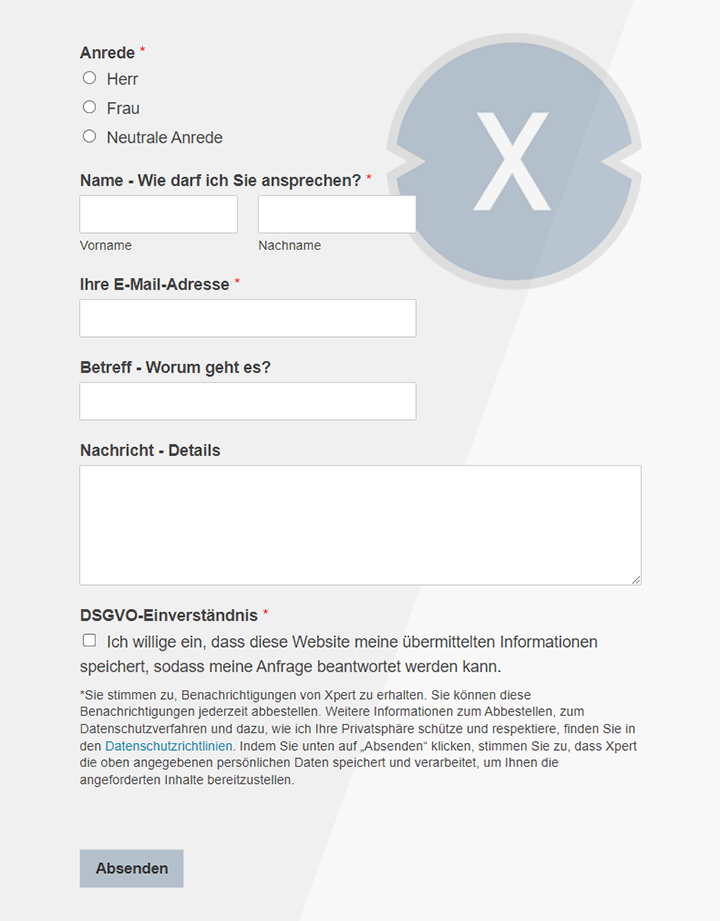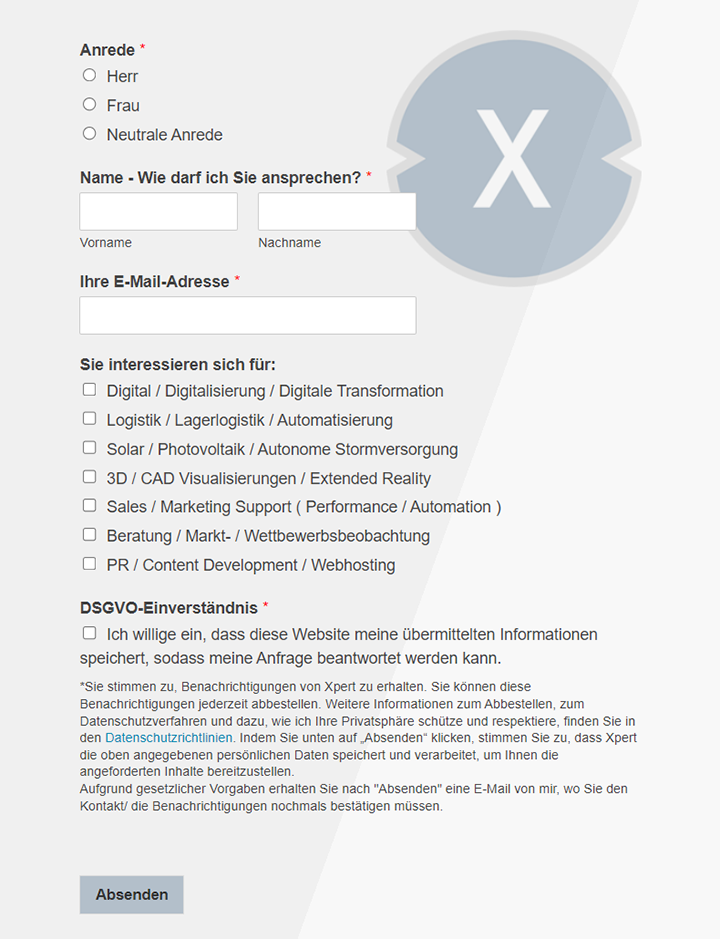Double strong: How the military necessity of the EU & NATO can drive civil traffic in Germany
Xpert pre-release
Language selection 📢
Published on: May 3, 2025 / update from: May 3, 2025 - Author: Konrad Wolfenstein

Double strong: How the military necessity of the EU & NATO can drive civil traffic in Germany - Image: Xpert.digital
Germany as the key player: Dual Use and the efficient infrastructure for the military and civil traffic (reading time: 29 min / no advertising / no paywall)
How the focus on military mobility accelerates defense resilience and civilian traffic in Germany and Europe
This article analyzes the profound synergies between strengthening military mobility and modernizing civilian transport infrastructure in Germany and Europe. The central thesis is that a targeted orientation of infrastructure planning and investments on military requirements not only significantly improves NATO and the EU's ability to defend and detort, but also acts as a catalyst for the civilian transition. This "double strong" effect results from the principle of double use (dual use), in which investments in more robust, more powerful and more resilient transport networks serve both military and civil purposes.
Due to its geostrategic location in the heart of Europe, Germany has a key role as a logistical hub ("Turntable Germany") for Allied forces. The ability to move troops and material quickly and efficiently through Germany (Host Nation Support) is essential for the credibility of collective defense. However, current deficits in the German infrastructure - from dilapidated bridges to bottlenecks in the rail network to bureaucratic hurdles - represent a strategic weak point.
Suitable for:
- Defense logistics: Germany's key role in the NATO strategy-how AI and robots can advance the Bundeswehr
The prioritization of military mobility requirements within the framework of EU initiatives such as the Military Mobility and NATO requirements promotes the necessary modernizations. Higher standards for loads, digital networking, cyber security and logistical capacities that are primarily military-motivated benefit from civil goods and passenger transport. They increase capacity, efficiency and resilience of the entire transport system and thus promote the goals of the turnover of the traffic. Financing mechanisms such as Connecting Europe Facility (CEF) create incentives to align national investments accordingly.
However, the implementation of this dual benefit requires overcoming considerable challenges: inadequate financing, lengthy approval procedures, security risks from hybrid threats and the need for improved civil-military coordination across institutional borders.
The double imperative - security and modernization
The current geopolitical landscape, characterized by the Russian attack war against Ukraine and growing global instabilities, is putting the need for robust defense ability and resilient logistics chains into the focus of European security policy. At the same time, Europe faces the challenge of a profound transformation of its transport systems towards more sustainability, efficiency and digitization - often summarized under the term "turnaround". This article argues that these two apparently separate imperative - security and modernization - can be synergetically connected by a strategic approach of double use (dual use) in transport. In particular, the focus on military mobility requirements can serve as a catalyst for accelerated modernization of civilian traffic logistics, of which both areas benefit equally.
Definition of dual use in transport infrastructure and logistics
The term "dual use" (double use) originally comes from export control and refers to goods, software and technologies that can be used for both civilian and military purposes. Historically, after the Second World War, he specifically referred to nuclear materials with potential for weapons and energy generation. Today the term is used far wider and includes a variety of products and technologies in areas such as electronics, computers, telecommunications, sensors, navigation, aerospace and chemistry. The EU and the United States' export control regulations aim to prevent the spread of weapons of mass destruction (MVW) and conventional armaments and to meet international security obligations.
In the context of the transport infrastructure and logistics, the concept goes beyond individual goods. Rather, it describes a strategic approach to planning, investing and operating transport networks and capacities. Dual-use infrastructure includes streets, railways, waterways, ports, airports as well as the associated digital communication and control systems, which are designed or upgraded in such a way that they meet both the requirements of civilian and freight transport as well as the specific needs of military operations. This includes aspects such as sufficient load -bearing capacity of bridges and streets for heavy military vehicles, suitable light space profiles for tunnels and underpasses, capacities for the envelope military equipment in ports and at airports, secure communication channels and increased resilience compared to physical or digital attacks.
This strategic perspective, to understand dual use not only as a property of goods, but as a planning principle is crucial. It is not about building infrastructure, which can also randomly be used militarily, but rather to take into account the requirements of both sectors from the outset and to design investments in such a way that a maximum mutual benefit is created. This approach is based on the EU's efforts to the infrastructure of its Member States as part of its action plans for military mobility and the requirements of NATO. The distinction between purely civil and military technologies or infrastructures is becoming increasingly difficult because the borders blur.
Military mobility as a driver for improved defense and civilian modernization
The central thesis of this article is that the prioritization of military mobility requirements in planning, financing and modernizing the traffic infrastructure generates a double dividend. It acts as a strong catalyst, which at the same time strengthens national and collective defense resilience and accelerates the modernization of civilian traffic logistics, ie the “traffic transition”. This synergistic effect, as indicated in the introductory text of the user request ("double strong"), is the key feature of the dual-use approach in the transport system.
The mechanism behind it is complex: military requirements for infrastructure are often more demanding than purely civil standards. This applies, for example, the load-bearing capacity of bridges and roads for heavy tanks and transport vehicles, the need for robust and redundant communication systems, increased demands on cyber security of logistics and control systems as well as the availability of specialized envelope capacities in logistics hubs. Investments that are made to meet these military requirements - often along strategically important corridors - lead to a general improvement in infrastructure quality. This also also benefits civilian users, in particular heavy freight transport, but also passenger traffic through increased network capacity and efficiency. The military necessity can thus initiate or accelerate investments, which would also be desirable to finance or prioritize from a civilian perspective.
Germany's role as a turntable ("Turntable Germany"))
Due to its geographical location in the center of Europe, Germany is of an outstanding strategic importance for the logistics and defense capacity of NATO and the EU. It acts as an indispensable turntable for the laying and care of Allied forces, especially in the direction of the eastern flank of the alliance. This role as a transit and recording meland (Host Nation) has become even more critical since the Russian invasion of Ukraine in 2022. NATO plans to be able to move massive reinforcements to the eastern flank if necessary, whereby a large part of these forces would have to pass and support here.
As part of the Host Nation Support (HNS), Germany is obliged to support allied forces in transit or stay. This includes a wide range of services, from the provision of rest areas, fuel and meals to transport support from field hunters to the guarantee of security and medical care, often in cooperation with civilian authorities and companies. The ability to effectively perform this HNS depends largely on a powerful and resilient traffic infrastructure.
However, Germany faces significant challenges here. Decades of neglect of military requirements in infrastructure planning and a general investment backlog have meant that parts of the German transport network may not be up to the potential stress in the event of crisis or defense. Dilapidated bridges, bottlenecks in the rail network and bureaucratic hurdles endanger Germany's function as a reliable turntable. The modernization of the infrastructure, taking into account military requirements, is therefore not only a question of efficiency, but a strategic need for national and European security.
Suitable for:
- System terminals buffer warehouse: multifunctional buffer bearing zones for containers and complete load trains (semi-trailer/trailer)
Germany: The strategic hub for European logistics and defense
Germany's central geographical location and its highly developed infrastructure in need of modernization predestine it as a strategic hub for military logistics and troop movements in Europe. This role brings considerable responsibilities, especially in the Host Nation Support (HNS), but also represents a strategic Achilles' heel in view of current challenges.
Geostrategic importance for NATO/EU laying
Germany forms the heart of European country traffic routes. Important transit corridors for road, rail and inland navigation traffic cross the country and connect Western Europe with the eastern and southeastern member states of NATO and the EU. These corridors are essential for the rapid laying of armed forces and materials, be it from the seaports in the Netherlands and Belgium (e.g. Rotterdam, Antwerp) or directly from the USA, Canada or Great Britain, towards potential areas of application on the eastern flank. The establishment of a cross -border "model corridor" for military traffic between the Netherlands, Germany and Poland underlines this strategic function and the need for coordinated plans.
In addition, Germany serves as the primary recording country (Receiving State) for reinforcement forces, especially from North America, which are reached by German sea and airports. The capacity and efficiency of these ports and airports as well as the subsequent further transport routes (in particular rail) are crucial for the so -called reception, staging, and onward movement (RSOM) - the intake, provision and further transfer of troops.
Germany also houses important command and logistics structures. The Joint Support and Enabling Command (JSEC) of NATO in Ulm coordinates all of the alliance's troop movements in the European alliance and is therefore a central switching point for military mobility. Germany is also involved in the Pesco project "Network of Loghubs", the goal of which is to build a European network of logistics hubs to store and prepare material transport. These nodes, such as the expanded Bundeswehr depot Süd in Pfungstadt, are intended to improve logistical support across national borders.
Host nation support (HNS): skills and responsibilities
Host Nation Support (HNS) refers to the civil and military support that a host country (host nation) grants the armed or friendly nations (Singing Nations) during their stay or transit on its territory. For Germany, HNS is a total task that takes place in close coordination between the federal, state, municipalities, the Bundeswehr and civilian actors, including the private sector.
The coordination of the HNS in Germany is the responsibility of the Bundeswehr Territorial Management Command (Terrfükdobw) in Berlin, which is responsible for all Bundeswehr operations in Germany. Since October 2024, the newly established support area of the Bundeswehr, which bundles logistical, medical service, ABC defense and field hunters, has also been significantly involved in HNS tasks. HNS is only granted on request, since foreign armed forces are not allowed to enter the German territory without permission, and the services rendered are generally chargeable and are charged to the applicant nation.
Historically, Germany has extensive experience with HNS, especially during the Cold War as part of the Wartime Host Nation Support (WHHNS) Agreement with the USA. At that time, tens of thousands of German reservists and considerable civilian resources were kept for the support of American reinforcements. Even if the structures and the scope have changed, the basic obligation remains and is becoming increasingly important in view of the current security situation. The range of HNS services is large and ranges from diplomatic approval procedures to transport support, provision of accommodation, meals, fuel and ammunition to repair services, medical care (also in civilian hospitals) and protection against sabotage or disorders.
The principle of the HNS is based on mutuality. German armed forces also receive support from alliance partners if they cross their territory for exercises or operations, for example when shifting through Poland to Lithuania.
Current logistical challenges and vulnerability
Despite its central role, Germany faces considerable challenges in ensuring military mobility. A main problem is the condition of the transport infrastructure. Many bridges, especially on highways, are ailing and do not correspond to the military load classes (MLC), which are required for the transport of modern combat tanks (over 70 tons). In rail transport, there are shortage of special wagons for armored transport (heavy truck), sufficiently long overtaking tracks and general capacity, which leads to bottlenecks. The rail network, which was once militarily optimized, has been dismantled and rationalized in recent decades, which can restrict its robustness and flexibility. The road network is also not consistently designed for large, heavy military convoys. The German Society for Foreign Policy (DGAP) concludes that military usability in infrastructure planning has increasingly got out of view in the past 30 years.
Another obstacle is bureaucratic procedures. Cross -border permits for military transports, especially for dangerous goods or oversized loads, are often lengthy and complex. Different national regulations and cumbersome customs formalities hinder a quick and smooth transit. Although EU initiatives such as Pesco Military Mobility and the EU action plan aim to simplify and harmonize, progress is often slow.
Capacity bottlenecks affect not only the infrastructure, but also the means of transport itself. The Bundeswehr lacks sufficient heavy -duty transporters and other logistics vehicles such as changing arteries. This leads to a strong dependence on civil freight forwarders, the integration of which must be contractually and organizationally ensured in the event of a crisis or defense. Conflicts between military requirements and civilian interests can arise here.
Security aspects are becoming increasingly important. The physical security of the transport routes is at risk from sabotage, as incidents have shown in the German rail network. At the same time, the advancing digitization of logistics and traffic control systems is an attack area for cyber attacks. A successful attack on telecommunications networks or traffic management systems could bring military transport to a standstill or reveal sensitive information. The use of foreign technology, for example in 5G networks along transport corridors, also harbors potential security risks.
These defects and vulnerability in German infrastructure and logistics are more than just operational problems. They develop into a strategic weak point that directly affects NATO's ability to quickly react and credible deterrence. If Germany cannot meet its role as a central hub due to infrastructure deficits, bureaucratic obstacles or security gaps, this undermines the entire defense architecture on the eastern flank. The ability to quickly lay reinforcement forces is a core component of the NATO strategy. A perceived inability to carry out these relocations in a timely manner weakens the deterrent effect towards potential aggressors and thus increases the risk of miscalculations and conflicts. The modernization of the German infrastructure, taking into account military requirements, is therefore of fundamental importance for stability in Europe.
🎯🎯🎯 Benefit from Xpert.Digital's extensive, fivefold expertise in a comprehensive service package | R&D, XR, PR & SEM

AI & XR 3D Rendering Machine: Fivefold expertise from Xpert.Digital in a comprehensive service package, R&D XR, PR & SEM - Image: Xpert.Digital
Xpert.Digital has in-depth knowledge of various industries. This allows us to develop tailor-made strategies that are tailored precisely to the requirements and challenges of your specific market segment. By continually analyzing market trends and following industry developments, we can act with foresight and offer innovative solutions. Through the combination of experience and knowledge, we generate added value and give our customers a decisive competitive advantage.
More about it here:
Europe in motion: military requirements that use all
Military mobility as a catalyst for infrastructure moderation
The need to improve military mobility in Europe has led to concrete initiatives and framework works at the level of NATO and the European Union. These not only serve to strengthen defense ability, but also affect the modernization of the civilian infrastructure by define specific requirements and provide financing mechanisms.
NATO and EU framework for military mobility
The European Union has recognized the improvement of military mobility as a strategic priority and started several initiatives since 2017. The first EU campaign plan for military mobility (2018) identified operational measures to eliminate physical, procedural and regulatory obstacles. Building on this, the action plan 2.0 (2022-2026) was adopted, which proposed the area of application and advised additional measures to react to the changed security situation after the Russian invasion of Ukraine. This plan aims at a well -networked military mobility network with shorter response times as well as powerful, safe, sustainable and resilient traffic infrastructure and capacities. New focus is on resilience and preparation (including strategic transport capacities), the digitization of administrative processes, protection against cyber and hybrid threats as well as strengthening partnerships, in particular with NATO, but also with countries such as Ukraine and Moldova.
An important instrument for implementation is the projects in the context of constant structured cooperation (Pesco). The “Military Mobility” project, coordinated by the Netherlands, focuses on simplification and standardization of cross -border military transport process. The “Network of Loghubs” project coordinated by Germany aims to build a European network of logistics nodes. It is noteworthy that third countries such as the USA, Canada and Norway have also been able to participate in Pesco projects, in particular “military mobility”, which underlines the transatlantic dimension.
NATO sees military mobility as a decisive “Force Enabler” for its deterrent and defense mission. It defines military requirements for the infrastructure and works closely with the EU to ensure coherence and synergies. A structured dialogue about military mobility between the two organizations has been serving the exchange about common priorities such as military requirements, transport infrastructure, dangerous goods transport, customs issues and cross -border permits since 2018. NATO brings its expertise particularly in the definition of critical infrastructure requirements, which can then be included in EU planning. The NATO command JSEC in Ulm plays a central role in coordinating troop movements in Europe.
Matches:
- Military logistics 4.0: The future of military supply chains - automation and civilian infrastructure as strategic factors for NATO
Translation of military requirements in infrastructure upgrades
A core aspect of military mobility initiatives is the systematic integration of military requirements in the planning and expansion of civilian transport infrastructure. EU and NATO define specific military requirements that can go beyond usual civil standards. These requirements are increasingly being integrated into the planning for the Trans-European Transport Network (TEN-V). The EU Commission has identified parts of the TEN-V network that are suitable for military transportation and creates priority lists for necessary resignations. The latest revision of the TEN-V regulation strengthens certain infrastructure requirements, especially for rails, and takes into account military needs in the network cards. A current focus is on the identification and upgrading of main corridors for short -term and large -scale military movements.
The upgrades include both physical content and digital modernizations. Physically, it is about the reinforcement of bridges and streets to higher military load classes (MLC), the adaptation of tunnel profiles, the expansion of railway lines for heavier and longer trains (possibly adaptation of the lane to limits), the improvement of the cover capacities in ports, airports and logistics nodes as well as ensuring resilient fuel supply along the transport routes.
Digitally, the requirements include the implementation of secure and interoperable communication systems for the control and monitoring of transports, the digitization of customs, approval and logistics processes to accelerate the processes as well as the strengthening of the cyber resilience of the entire transport and logistics infrastructure against attacks. Initiatives such as the NATO Innovation Challenge are looking for innovative digital solutions for transport planning and interoperability.
The role of dual-use financing mechanisms
In order to promote the necessary investments in dual usable infrastructure, the EU has created specific financing instruments. The most important thing is Connecting Europe Facility (CEF). As part of the multi-year financial framework (MFF) 2021-2027, a budget of around 1.69 billion euros was specially provided for the co-finance of dual-use transport infrastructure projects that meet military requirements. Although this sum is significantly below the original proposal of the Commission (6.5 billion euros) and the demand exceeds the supply by far (the applications have overcome the budget partly around 4.7 times), it still represents an important incentive. In view of the urgency, the funds were already exhausted. Additional funds have been announced, but the question of sufficient financing remains.
The existence of these paid EU funds for dual-use projects has a significant signal effect. It creates a strong incentive for Member States such as Germany to align its national infrastructure planning more on military mobility requirements. National ministries (traffic, defense, finance) are encouraged to prioritize projects that meet both civil and military criteria in order to maximize their chances of EU cofinance. This helps to weight military issues higher and to promote the integration of defense needs into comprehensive modernization plans for the infrastructure.
In addition to the CEF, the need to open up further sources of financing is discussed. This could include synergies with other EU programs such as the Global Gateway Initiative that promotes investments in global infrastructure projects. The European Investment Bank (EIB) loans, which has now also opened its portfolio for security and defense investments, could also play a role. Nevertheless, national households remain the main finance source, which underlines the need for a clear priority setting.
Military vs. civil infrastructure standards & double use implications
The following table illustrates as an example of how military requirements differ from typical civil standards and which dual-use upgrades can result.
Military infrastructure standards often set higher technical requirements than civil standards, which leads to qualitative improvements in dual-use projects, both sectors benefit. For example, road bridges are reinforced to carry military loads such as tanks, which also increases their load -bearing capacity in the civilian area. Railway lines are expanded for higher axle loads and longer trains, while tunnels receive larger cross -sections for large military devices. Ports are upgraded with roro ramps and safe warehouse areas, and digital networks are hardened by encrypted, interoperable communication. Logistics hubs also benefit from extended storage capacities, including special dangerous goods warehouse. These upgrades not only strengthen military resilience and operational efficiency, but also modernize civilian transport infrastructure. This creates a win-win situation in which military and civilian requirements are optimally combined and a strategic basis for defense, deterrent and the "turnaround" are created.
This table illustrates that military requirements often set higher technical standards. The implementation of these standards as part of dual-use projects leads to a general increase in quality of the infrastructure, from which both military and civil sector benefit.
Synergies and mutual benefits: defense resilience and civilian “traffic transition”
The strategic focus on dual-use infrastructure creates a win-win situation by strengthening military ability to act and at the same time modernizing the civilian transport infrastructure. This "double strong" effect manifests itself in a variety of, mutually reinforcing advantages for defense and society.
Strengthening defense resilience
A modernized infrastructure tailored to military needs is fundamental for defending and deterrent.
Speed and responsiveness:
Provisional transport corridors, powerful logistics hubs and simplified cross-border methods enable significantly faster laying of NATO and EU staff. Shorter response times are crucial for credible deterrence and an effective crisis reaction at the external borders. The removal of bureaucratic hurdles, as long waiting times for permits, also contributes significantly to the acceleration.
Period (sustainment):
Improved logistics hubs and secure transport routes ensure reliable supply of the troops used with supplies (ammunition, fuel, spare parts, meals). Robust logistics is the prerequisite for the perseverance of military operations over longer periods. The ensuring of the fuel supply chain is particularly critical.
Interoperability:
The standardization of infrastructure parameters (e.g. cargo classes, rail flow systems, communication protocols) and harmonized procedures facilitate cooperation and smooth interaction of various national armed forces that use Germany as a transit country. This increases the effectiveness of multinational operations.
Deterrence:
A visibly improved ability to quickly and in relevant strength to be relocated and supply strengthens strengthens the credibility of collective defense and thus the deterrent effect of NATO as a whole. Potential opponents recognize that the alliance is able to act.
Suitable for:
- Du logistics² | Double dual-use logistics: integration of rail and street for civil and military purposes
Acceleration of the “traffic transition” (civil transportation modernization)
Investments in dual-use infrastructure not only benefit the defense, but also significantly promote the goals of the civil traffic transition.
Increased capacity and relocation potential:
Infrastructure, which is designed for severe military transports (e.g. bridges with a high load, powerful rail routes), also offers considerable advantages for civil freight traffic, especially heavy goods traffic. Improved rail infrastructure can increase the attractiveness of rail freight traffic and thus contribute to the desired shift of transports from the road to rail.
Improved efficiency and connectivity:
The expansion of bottlenecks, the modernization of traffic corridors and the digitization of logistics processes increase the efficiency of the entire transport system. All civilian users benefit from this through shorter transport times and potentially lower costs. The better connection of various modes of transport (e.g. ports to the rail network) is also funded.
Technological progress:
Military requirements can promote innovations in areas that are also relevant to civil. Examples include secure digital logistics platforms, resilient communication networks, advanced materials in bridge construction or new methods for monitoring and controlling traffic flows. These technologies can diffuse into the civilian sector ("Spill-over").
Increased resilience:
Infrastructure, which is hardened against physical attacks (sabotage) or cyber attacks for military reasons, is automatically more resistant to other disorders such as natural disasters, technical failures or criminal actions. This increases the reliability of civilian supply chains and mobility as a whole.
The "double strong" effect: strategic and socio-economic goals in harmony
The dual-use approach makes it possible to reconcile strategic defense payments with national economic, social and ecological goals.
Target orientation:
Investments in dual usable infrastructure also pay for safety provision and the targets of the traffic turnaround, such as more efficient goods transport, reduction in traffic jams and emissions through transfer of traffic and adaptation to climate change through more resilient infrastructure.
Resource optimization:
The military necessity can serve as a lever to justify and finance investments in infrastructure projects that also bring considerable civilian advantages. Instead of competing for defense and traffic households by the dual-use approach, public funds can be used more efficiently in order to pursue several political goals at the same time.
This approach transforms the perspective to infrastructure investments. Instead of a potential competition for resources between the defense sector and civil sectors, a synergistic partnership is created. Military requirements that often go beyond civilian standards act as a "specification booster". The resulting higher -quality infrastructure offers better performance for civilian purposes.
At the same time, the strategic imperative of the defense acts as a "financing catalyst", which mobilizes political support and can open up additional sources of money (such as CEF) to implement projects that also advance civilian goals such as the traffic turnaround. Military needs not only coexist with civilians, but actively drive the development of more powerful and more resilient infrastructure for the benefit of both areas.
Assignment of militarily driven upgrades to defense and civil benefits
The following table shows concrete examples of the "double strong" effect by linking militarily motivated upgrades with its specific advantages for defense and civil traffic contact
The examples show the "double strong" effect, in which militarily motivated upgrades at the same time create advantages for defense and civil traffic transition. For example, the bridge reinforcement on MLC 70+ enables the transport of heavy battle tanks, but also makes civilian heavy load transports easier and thus increases the capacity and flexibility of the road network. The expansion and electrification of railway lines and the implementation of the ETCS system not only promote faster and more capacity military transports, but also increase capacity and speed in civilian rail freight transport, which shifted freight traffic from the road to rail and reduces emissions. The cyber hardening of port logistics systems serves to protect against sabotage and espionage in military operations and at the same time increases the safety and reliability of civil supply chains, which strengthens the resilience of critical infrastructure. Digital and harmonized cross -border approval procedures shorten the laying times of multinational forces and at the same time accelerate civilian customs handling processes, which makes cross -border trade and traffic more efficient. The establishment of logistics hubs with dangerous goods storage capacity ensures the secure storage of ammunition and operating substances and in parallel improves the infrastructure for civilian dangerous property logistics, which achieves higher security standards and improved supply security. Resilient communication networks along traffic corridors ensure the management and communication of military convoys and at the same time ensure more stable network coverage for civilian users, which increases the crisis resistance of communication as a whole. These examples illustrate these investments initiated by military requirements not only strengthen defense ability, but also promote the modernization and efficiency of the civil traffic sector.
These examples illustrate how specific investments, often initiated by military requirements, create direct and measurable added value for both the ability to defend and the modernization and performance of the civilian transport sector.
Our recommendation: 🌍 Limitless reach 🔗 Networked 🌐 Multilingual 💪 Strong sales: 💡 Authentic with strategy 🚀 Innovation meets 🧠 Intuition
At a time when a company's digital presence determines its success, the challenge is how to make this presence authentic, individual and far-reaching. Xpert.Digital offers an innovative solution that positions itself as an intersection between an industry hub, a blog and a brand ambassador. It combines the advantages of communication and sales channels in a single platform and enables publication in 18 different languages. The cooperation with partner portals and the possibility of publishing articles on Google News and a press distribution list with around 8,000 journalists and readers maximize the reach and visibility of the content. This represents an essential factor in external sales & marketing (SMarketing).
More about it here:
Germany as a NATO hub: Double use of the infrastructure and the strategic priorities correctly set correctly
Challenges and considerations for effective double use implementation
Despite the considerable potential of the dual-use approach, there are a number of challenges and pitfalls that need to be addressed in order to successfully implement the desired synergies. These range from financial to bureaucratic to security and organizational aspects.
Financing gaps and investment prioritization
Inadequate financing is a central obstacle. The funds provided for dual-use projects as part of the EU Connecting Europe Facility (CEF) (approx. 1.7 billion euros + 0.8 billion euros) are generally considered too low in relation to the actual need. The high exaggeration rate of the conveyor calls underlines this. National households are also under pressure, and it is questionable whether funds such as the German 100-billion euro special assets for the Bundeswehr, which is primarily intended for equipment, can also be used to a sufficient extent for the urgently needed infrastructure moderation.
The limited funds require a strict prioritization. Difficult decisions must be made which traffic corridors and which specific projects (bridges, rail sections, ports, etc.) should be given priority. Here, short-term military necessities that result from the current threat situation and NATO planning (e.g. New Force Model) must be reconciled with long-term civil development goals and network planning (e.g. TEN-V). This requires complex coordination processes.
Bureaucratic simplification and cross -border harmonization
Despite repeated commitments and initiatives at EU level, lengthy and complex bureaucratic processes remain a significant obstacle to military mobility. In particular, the cross -border approval of transports, especially for dangerous goods and excessive/overwhelming loads, as well as customs formalities can take days or weeks and hinder quick installations. National regulations and procedures often divergence between the Member States. The EU strives for a maximum period of three working days for permits, but admits that this requires considerable national efforts.
A comprehensive digitization of administrative processes (application, approval, customs processing) is the key to acceleration and simplification. However, this not only requires investments in appropriate IT systems, but also their interoperability across national borders and the willingness of the authorities to accept and apply digital procedures.
Security, resilience and threat defense
The traffic infrastructure is an attractive goal for various threats. Physical sabotage files, as they already had in the German rail network, can paralyze the traffic over a large area. With increasing digitization, vulnerability towards cyber attacks on control systems, communication networks and logistics platforms increases. Such attacks can not only disturb the military deployment, but also compromise sensitive data or to interrupt civilian supply chains. Special attention requires special attention to the security of technologies from potentially problematic third countries, such as Chinese components in 5G networks along important transport routes. New EU regulations for data release (Data Act) also have to be considered from a security perspective in order to prevent sensitive infrastructure data from falling into the wrong hands.
The protection of critical transport infrastructure (criticism) therefore requires comprehensive measures. This includes physical security, robust cyber security architectures, redundant systems and emergency plans. Corresponding legal regulations (such as the planned criticism roof in Germany) must adequately take into account the specific requirements of the transport sector and, if necessary, prescribe certifications for critical components.
Suitable for:
Contribution of military specifications with civilian and ecological needs
While military requirements often set higher standards, when planning dual-use infrastructure, care must be taken to ensure that they do not lead to oversized or disproportionately expensive solutions that are impractical for the primary civilian purpose. It is important to find a meaningful compromise that ensures essential military skills without affecting civilian usability or economy.
In addition, environmental aspects and climate protection goals must be taken into account. The construction and operation of transport infrastructure has a significant impact on the environment. When planning dual-us projects, environmental impact assessments must therefore be carried out and sustainable construction methods and energy-efficient operating concepts are sought. The promotion of climate silence of the infrastructure is also an important goal of the EU action plans.
Optimization of civil-military coordination
The successful implementation of a dual-use strategy requires close and effective cooperation between a variety of actors on different levels. This includes Defense Ministries, Ministries of Transport, Interior Minister, subordinate authorities at the federal and state level, the European Union, NATO and last but not least the private sector (transport company, construction industry).
This coordination is complex and often comes across institutional silos and different cultures, priorities and planning horizons. Defense planners think in military scenarios and ability requirements, while traffic planners focus on civilian needs analyzes and economy. Private companies primarily pursue economic goals that do not always match the requirements for flexibility and provision for the crisis. In order to bridge these trenches, institutionalized coordination mechanisms are necessary. The EU recommends the establishment of national interminister and cross -departmental coordination groups. A clear contractual regulation of cooperation with the private sector, which includes aspects such as remuneration, liability in the event of a crisis and incentives for investments in dual-use skills, is also essential.
The success of the entire dual-use strategy depends crucially on whether it is possible to overcome these institutional barriers and to establish a real, permanent culture of cooperation. This requires more than just political declarations of intent; Clear responsibilities, transparent processes, regular exchange of information and political will to think and act across departments. Without such an integrated approach, the potential synergies threaten to run in the sand.
Suitable for:
Germany's key role: Logistics in the area of tension between NATO and traffic transition
The analysis has shown that the focus on military mobility requirements in the development of the transport infrastructure has considerable potential in order to strengthen both Germany and Europe's defense resilience and to accelerate the civilian traffic turnaround. The dual-use approach offers the opportunity to combine strategic security interests with socio-economic modernization goals synergetically.
Summary of the results: validation of the double-benefit hypothesis
The investigation confirms the central thesis of the report: Prioritization of military requirements in infrastructure planning acts as a catalyst for a double dividend.
For defense:
Modernized, resilient and interoperable transport routes enable faster troops, more robust logistical support and thus increase the reaction ability, perseverance and credibility of collective defense and deterrence.
For the civilian traffic transition:
The upgrades driven by military requirements (higher loads, better connectivity, digitization, resilience) increase the capacity, efficiency and resilience of the entire transport system, of which civilian passenger and freight transport can benefit directly and what can support the shift to more environmentally friendly modes of transport.
Germany's role as a central logistical hub for NATO and EU is of outstanding importance. The investment in its dual -usable infrastructure is therefore not just a national concern, but a strategic need for European security.
At the same time, it became clear that the full implementation of this potential is hindered by significant challenges. This includes above all financing gaps, bureaucratic obstacles in cross-border methods, growing security threats in the physical and cyber space as well as defects in civil-military coordination.
Suitable for:
- The challenge of the German rail network: capacity bottlenecks and solution strategies for the supply chain
Recommendations for action for the infrastructure of the future: interface between civil and military use
In order to fully exploit the potential of the dual-use approach and address the identified challenges, concerted efforts are required at different levels:
For politics (National & EU):
- Make funding: The earmarked funds for dual-use infrastructure as part of the CEF should be increased substantially. National households must also provide sufficient funds and synergies must be checked with other funding instruments (e.g. EIB, national economic programs).
- Institutionalize coordination: Binding national coordination points with clear mandates for cross-departmental planning and implementation of dual-use infrastructure projects and the control of the Host Nation Support should be set up, as recommended by the EU.
- Accelerating the procedure: The digitization and harmonization of cross-border approval and customs procedures must be promoted with the highest priority in order to achieve the desired short deadlines (e.g. 3 days for permits).
- Strengthening resilience: Robust cyber security standards and physical protective measures must be integrated into the planning and construction of all critical transport infrastructures. National criticism legislation must be adapted and enforced accordingly.
- Deepen EU Nato cooperation: the coordination between the EU and NATO in the definition of military requirements, infrastructure planning and the implementation of exercises should be further intensified.
For the defense (Bundeswehr):
- Clearly define requirements: The Bundeswehr must formulate its long-term infrastructure requirements, derived from the NATO New Force Model, the national defense plans (OPLEU) and the HNS obligations, and proactively bring them into civil planning processes.
- Expand partnerships: Cooperation with civil planning authorities and the transport industry must be intensified. This includes building trust, clear contractual regulations for the integration of civilians capacities if necessary and, if necessary, incentives for the provision of dual-use skills by industry. At the same time, your own military core skills (e.g. heavy load transport) must be preserved and modernized.
- Practice, practice: regular, realistic exercises to lay large associations (also scheduled at short notice, “ad hoc exercises”) are essential in order to test and uncover the functionality of the infrastructure, the procedures and the civil-military interfaces.
For industry (transport & construction):
- Proactive act: Companies should actively find out about military requirements and dual-use funding opportunities and signal their willingness to cooperate. The predicate "We drive for the Bundeswehr" could serve as a quality feature.
- Investing in skills: Targeted investments in equipment (e.g. vehicles, handling technology), personnel qualification and digital systems that meet both civil and potential military requirements can strengthen your own competitiveness and open up new business areas.
- Promote innovation: Industry is required to develop and offer innovative and resilient solutions for the construction and operation of dual-use infrastructure.
The need for an integrated, total -state approach
The realization of the "Double strong" vision is not a task for a single department or a single player. It requires an integrated, total-state and social approach ("Whole-of-Government / Whole-of-Society Approach"). Only by overcoming traditional institutional silos and the establishment of a real, permanent cooperation culture between all relevant actors-ministries, authorities at all levels, Bundeswehr, international partners (EU/NATO) and the private sector-can the complex challenges be mastered and the considerable synergies of the dual-use approach are raised. This requires a common understanding of the strategic necessity, coordinated priorities and the sustainable political will to implement. The strengthening of military mobility is therefore not only a defense policy task, but a total state modernization project with far -reaching benefits for security and prosperity in Germany and Europe.
Advice - planning - implementation
I would be happy to serve as your personal advisor.
Head of Business Development
Chairman SME Connect Defense Working Group
Advice - planning - implementation
I would be happy to serve as your personal advisor.
contact me under Wolfenstein ∂ Xpert.digital
call me under +49 89 674 804 (Munich)
We are there for you - advice - planning - implementation - project management
☑️ SME support in strategy, consulting, planning and implementation
☑️ Creation or realignment of the digital strategy and digitalization
☑️ Expansion and optimization of international sales processes
☑️ Global & Digital B2B trading platforms
☑️ Pioneer Business Development
I would be happy to serve as your personal advisor.
You can contact me by filling out the contact form below or simply call me on +49 89 89 674 804 (Munich) .
I'm looking forward to our joint project.
Xpert.Digital - Konrad Wolfenstein
Xpert.Digital is a hub for industry with a focus on digitalization, mechanical engineering, logistics/intralogistics and photovoltaics.
With our 360° business development solution, we support well-known companies from new business to after sales.
Market intelligence, smarketing, marketing automation, content development, PR, mail campaigns, personalized social media and lead nurturing are part of our digital tools.
You can find out more at: www.xpert.digital - www.xpert.solar - www.xpert.plus



































